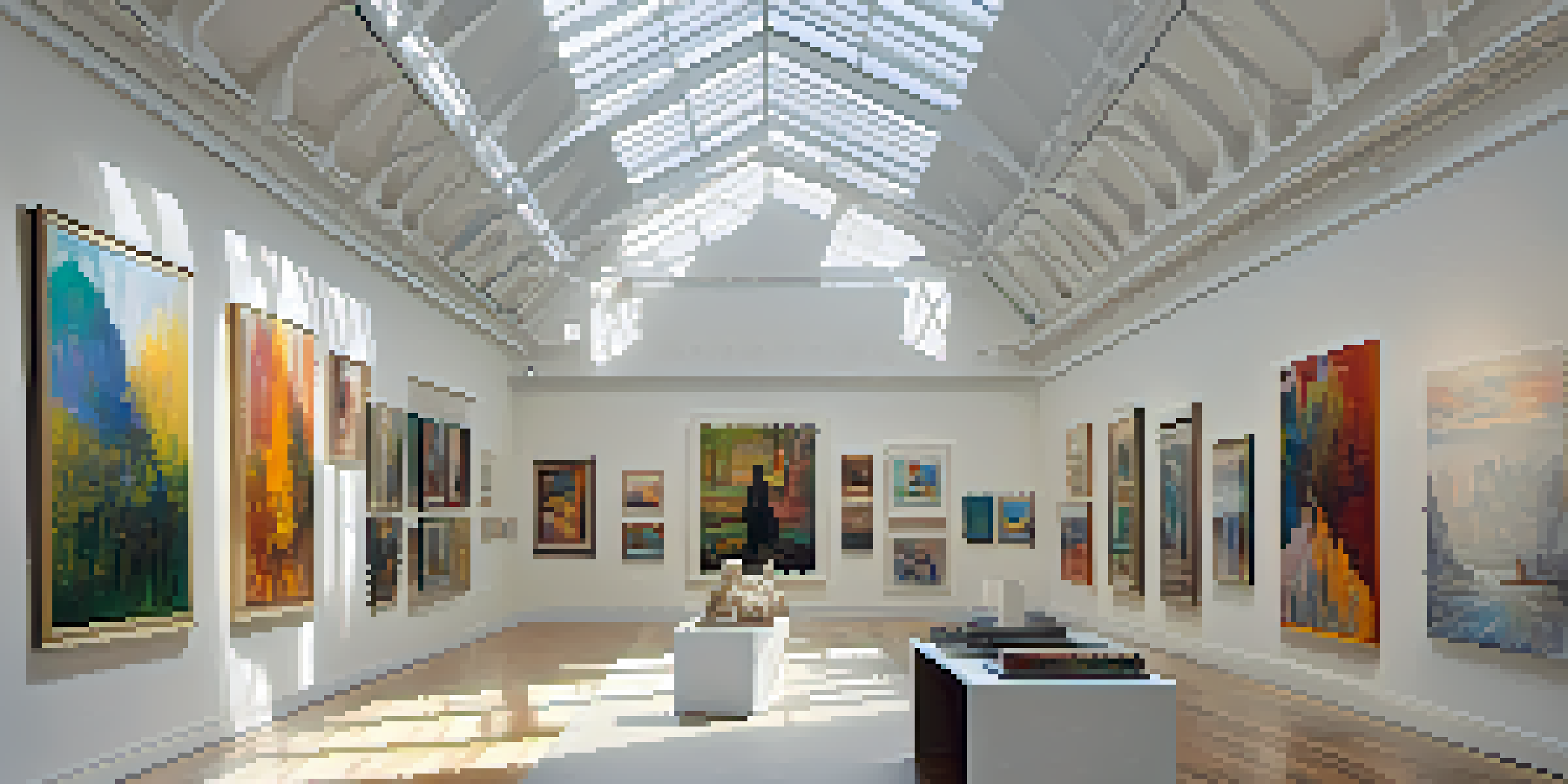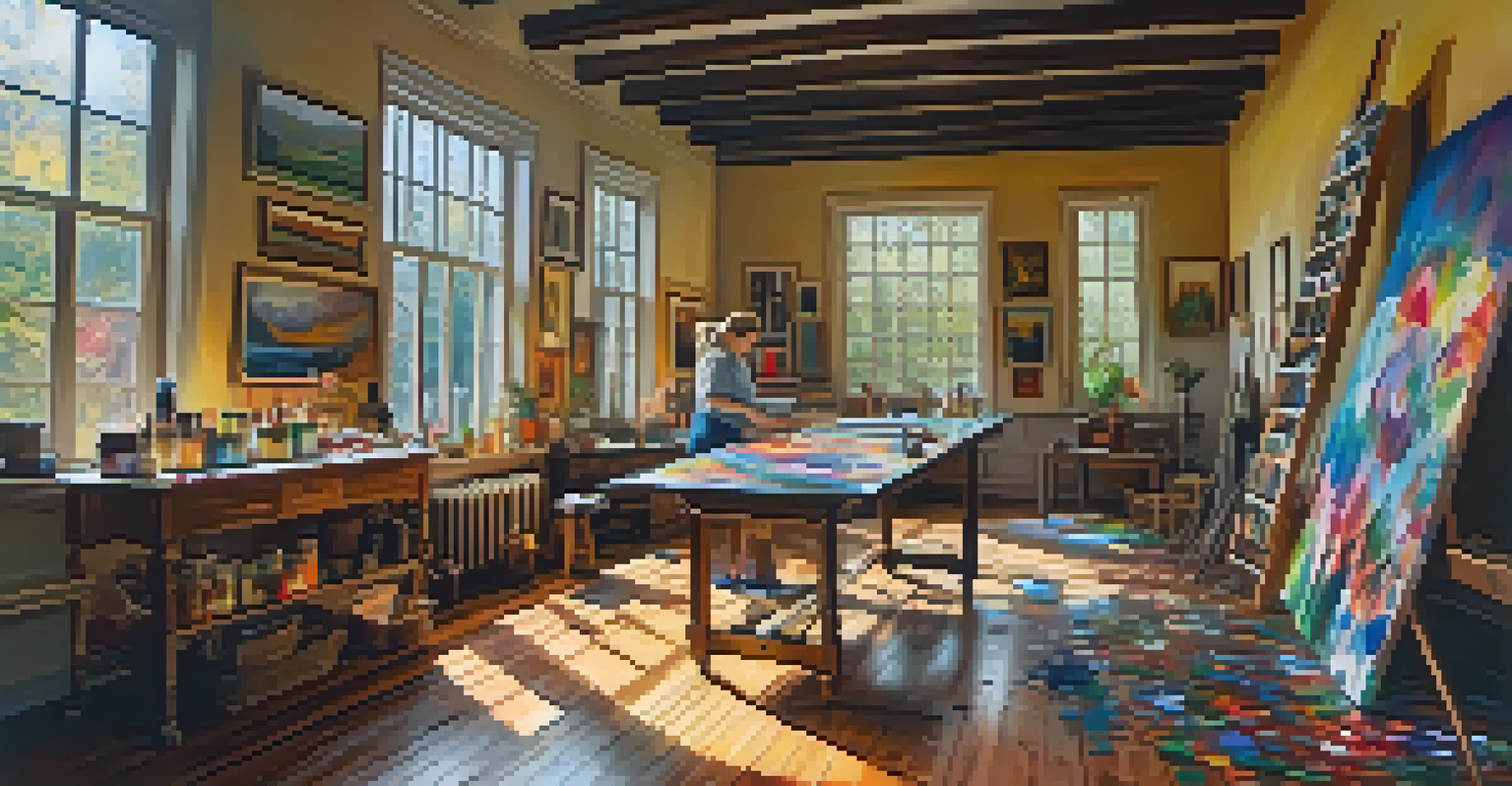The Impact of Globalization on Contemporary Painting Styles

Globalization: A Brief Overview in the Art World
Globalization refers to the interconnectedness of cultures and economies across the globe. In the art world, this phenomenon has led to a remarkable exchange of ideas, techniques, and traditions. Artists are no longer limited by geographical boundaries, which allows for a rich tapestry of influences in contemporary painting.
Art is the most beautiful of all lies; it is a mirror of the world in which we live.
As artists draw inspiration from various cultures, they blend styles and techniques, creating unique hybrids that reflect a global perspective. This cross-pollination of artistic practices can be seen in the works of many contemporary painters who incorporate elements from diverse traditions. For example, a Western artist might utilize techniques from Eastern calligraphy, resulting in a fresh and innovative approach.
Moreover, global communication channels, such as social media and online galleries, have democratized access to art. Artists can showcase their work to a worldwide audience, fostering a sense of community that transcends borders. This accessibility not only influences individual artists but also shapes the overall landscape of contemporary painting.
Cultural Exchange: The Heart of Globalization in Art
Cultural exchange plays a pivotal role in shaping contemporary painting styles. By engaging with different cultures, artists discover new themes, symbols, and narratives that enrich their work. This exchange often results in the fusion of traditional motifs with modern techniques, creating compelling visual dialogues.

For instance, the incorporation of indigenous patterns in contemporary art can be seen as a celebration of heritage and identity. Artists like Kehinde Wiley, who uses traditional portraiture to highlight contemporary subjects, exemplify how cultural exchange can elevate modern painting. These interactions not only enhance aesthetics but also provoke thought and discussion around identity and representation.
Globalization Enriches Artistic Diversity
The interconnectedness of cultures allows artists to blend styles and techniques, resulting in unique contemporary artworks.
Additionally, art festivals and international exhibitions further facilitate this exchange, providing platforms for artists to collaborate and learn from one another. These events often showcase a diverse range of styles, encouraging artists to experiment and innovate. As a result, the contemporary painting scene becomes a melting pot of ideas, reflecting a shared human experience.
Technological Advancements and Their Artistic Impact
The rise of technology has transformed the way artists create and share their work. Digital tools and platforms allow for experimentation with different mediums and styles, breaking traditional boundaries. For example, digital painting has gained popularity, enabling artists to explore new techniques without the constraints of physical materials.
The role of the artist is to ask questions, not to answer them.
Moreover, the accessibility of online art communities fosters collaboration and inspiration. Artists can easily connect with peers across the globe, sharing techniques, feedback, and resources. This interconnectedness has led to the emergence of new trends in painting, as artists borrow and adapt ideas from one another.
However, this technological influence also raises questions about authenticity and originality. With so many artists drawing from similar sources, finding a unique voice can be challenging. Nevertheless, the ongoing dialogue between technology and traditional painting continues to push boundaries, resulting in innovative and diverse contemporary styles.
Economic Factors: Shaping Artistic Expression
Economic globalization has significant implications for contemporary painting. As markets expand, artists gain access to broader audiences and potential buyers, which can influence their creative choices. The demand for art that resonates with global themes often encourages artists to explore topics such as migration, identity, and environmental issues.
This economic context also leads to the commercialization of art, where artists might feel pressure to conform to market trends. While this can compromise artistic integrity, it also presents opportunities for artists to engage with contemporary issues that resonate with their audience. The delicate balance between commercial viability and personal expression is a challenge many artists navigate today.
Cultural Exchange Shapes Modern Art
Engagement with various cultures enables artists to incorporate new themes and narratives, enhancing the richness of contemporary painting.
Additionally, funding from international art organizations and sponsorships can significantly impact an artist’s work. Grants and residencies often allow artists to explore new ideas and materials, leading to innovative projects. This financial support can be a double-edged sword, as it may also steer artists toward creating work that aligns with the expectations of their sponsors.
Political Contexts: Influencing Artistic Narratives
The political landscape of different countries plays a crucial role in shaping contemporary painting. Artists often respond to political events and social movements, using their work as a form of expression or protest. This engagement can lead to powerful narratives that resonate with viewers on a global scale.
For example, the rise of social justice movements has inspired many artists to address themes of inequality and injustice. By incorporating these themes into their work, they can spark conversations and encourage activism. This connection between art and politics not only enriches the narrative of contemporary painting but also highlights the artist's role as a societal commentator.
Furthermore, governmental policies regarding art funding and censorship can impact the freedom of expression for artists. In some regions, artists face restrictions that challenge their ability to convey their messages. Yet, many find innovative ways to bypass these limitations, often resulting in art that is even more poignant and thought-provoking.
The Role of Art Institutions in a Globalized World
Art institutions, such as museums and galleries, play a vital role in promoting and preserving contemporary painting styles influenced by globalization. These institutions often curate exhibitions that showcase a diverse range of artists, reflecting the interconnectedness of the global art scene. By highlighting underrepresented voices, they contribute to a richer understanding of contemporary art.
Additionally, art institutions frequently collaborate with international partners to foster cultural exchange. These collaborative projects can lead to innovative exhibitions that challenge traditional narratives and encourage dialogue. The involvement of various stakeholders, including artists, curators, and audiences, creates a dynamic environment that nurtures creativity.
Technology Transforms Artistic Creation
Advancements in technology facilitate experimentation and collaboration among artists, pushing the boundaries of traditional painting.
However, the influence of art institutions can also be a double-edged sword. While they offer platforms for artists to gain visibility, they can also perpetuate certain narratives. The challenge lies in ensuring that these institutions remain inclusive and representative of the diverse voices that define contemporary painting today.
Contemporary Painting: A Reflection of Global Society
Ultimately, contemporary painting serves as a mirror reflecting the complexities of our global society. The interplay of cultural, technological, economic, and political factors creates a rich tapestry of artistic expression. Each painting tells a story, not only about the artist but also about the world we live in.
As globalization continues to evolve, so too will the styles and narratives within contemporary painting. Artists are likely to explore new themes that resonate with a rapidly changing world, drawing from a diverse array of influences. This adaptability ensures that contemporary painting remains relevant and engaging.

In conclusion, the impact of globalization on contemporary painting is profound and multifaceted. By embracing this interconnectedness, artists can create works that not only captivate audiences but also provoke thought and inspire change. The future of contemporary painting is bright, as it continues to evolve in response to our global society.